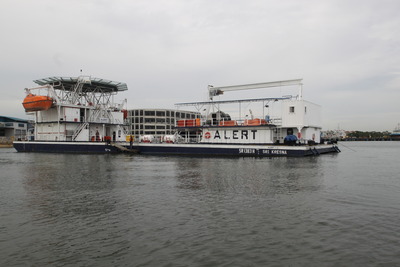Floating maintenance service to keep lifting equipment in working order
Tuesday, 20 March, 2012
Alert Disaster Control (Asia), a Singapore-headquartered global emergency response and integrated risk management solutions service company, has signed a service maintenance contract with Konecranes that helps the company keep the vital lifting equipment on its training vessel Alert 1 - Sri Kresna in working order. The 180-foot training vessel, which is used to teach advanced safety and survival-at-sea practices in conjunction with extensive shore-based training facilities, is central to the safety, survival and technical training curricula offered by Alert.
Alert was founded in 1988 in response to the need for global emergency response to oilwell fires and blowouts, as well as the necessity for pre-emptive risk management services designed to eliminate the occurrence of such emergencies or, at the very least, alleviate the frequency and severity of such incidents.
The service contract with Konecranes of Singapore helps to maintain key lifting technology on the vessel, which is moored off Loyang Offshore Supply Base, a purpose-built industrial estate on the city-state’s eastern shores. The estate supports the offshore oil and gas equipment manufacturing industry, which has experienced tremendous growth, underlining Singapore’s global position in rig building and ship conversions. “Konecranes, which was established in Singapore in 1970, was one of the very few companies offering this service when we initially established the Alert regional operations base in the 1980s,” recalled Alert Director Debbie P Allcorn. “We wanted a company that could provide the specialised performance that Konecranes was able to.”
The Alert 1 - Sri Kresna contains specialised equipment that includes totally enclosed, motor-propelled survival craft (lifeboats) and fast rescue boats and a full-size helicopter simulator that can be submerged in a tank on the vessel, mimicking a downed helicopter on the ocean surface. Occupants must learn to evacuate from the simulator, deploy inflatable life rafts and implement survival and search and rescue techniques in order to reach safety.

Regular visits by maintenance professionals from Konecranes ensure that the other lifting and lowering equipment aboard the vessel, including that used by the lifeboat and rescue craft, is functioning properly and unaffected by heavy usage and the humid salt air. This equipment includes winches, davits, motor propulsion units and electronic remote control systems.
Konecranes must be able to respond immediately in the event of an unscheduled equipment service requirement, since the client’s training programs - with attendees from the major oil exploration and production companies and supporting marine and well service industries from anywhere in the world - cannot be held up.
“Konecranes have always been very good at this,” Allcorn said. “If circumstances dictate, we are able to get them down here within the hour. While this has fortunately only occurred on a rare occasion in the past - the Konecranes personnel have performed extremely well.
“A further challenge for Konecranes is that we’re located offshore. When we took them on as our service contractor, the fact that our training vessel was reachable only by boat was an impediment to other service providers, but not to Konecranes. They were prepared to service the vessel, despite having to be ferried out to it,” she said.
“Konecranes are also transparent in their dealings. They fully debrief us on what needs to be serviced or replaced and provide us with a quotation for the same immediately following their site assessment. This has truly supported our ability to continually ensure optimum maintenance and performance of all of our lifting systems. We’ve never had a problem with Konecranes on this,” Allcorn said. Allcorn further said that the company considers Konecranes one of its top five suppliers in terms or service commitment and reliability.
Alert has recently affirmed its relationship with Konecranes through the purchase of a new 3.2-ton Konecranes overhead crane for its shore-based operations facilities. According to Tan Boon Lee, Sales Manager, Maintenance Services, Konecranes Singapore, one of the reasons for setting up a preventive maintenance program, other than safety and legislation, is to prevent unscheduled equipment breakdowns.
What is the work-related impact of long-term back problems?
Australian researchers have set out to project the work-related impact of long-term back problems...
Can human–robot collaboration tackle manual handling challenges?
Australian engineers have trialled a human–robot collaboration system designed to make...
Construction materials company extends road safety program
Australia's largest vertically integrated construction materials company has extended its...








